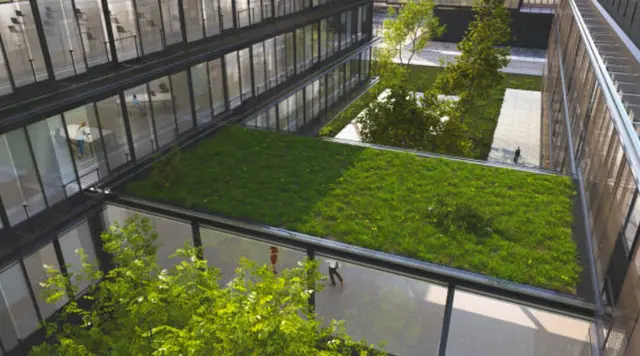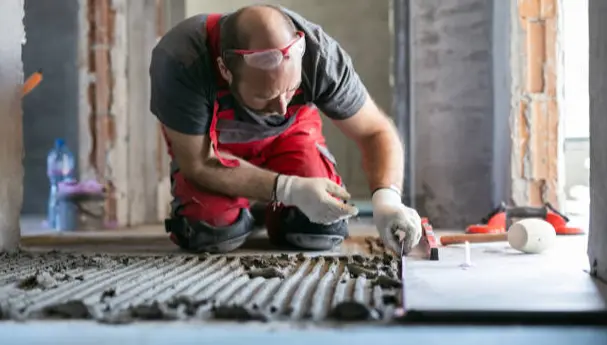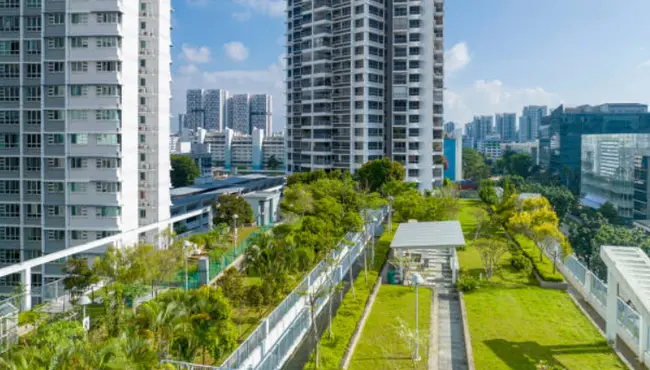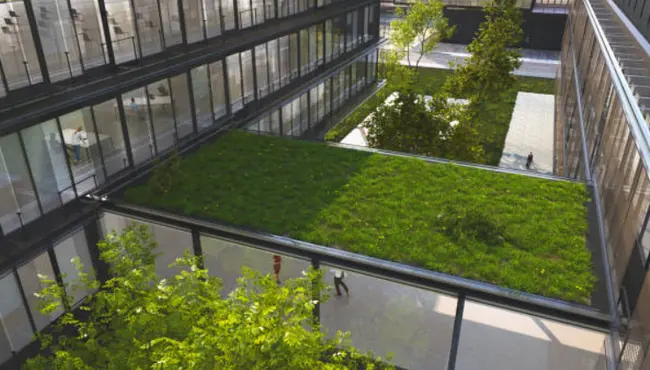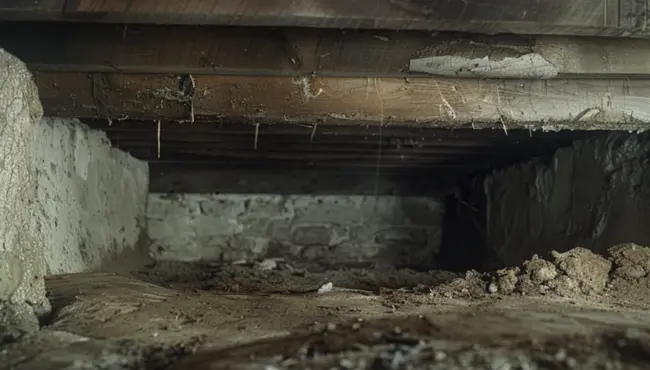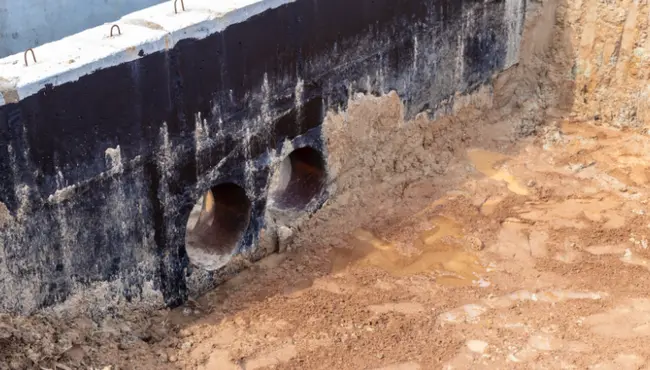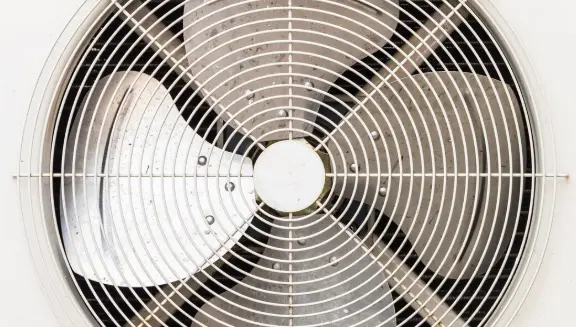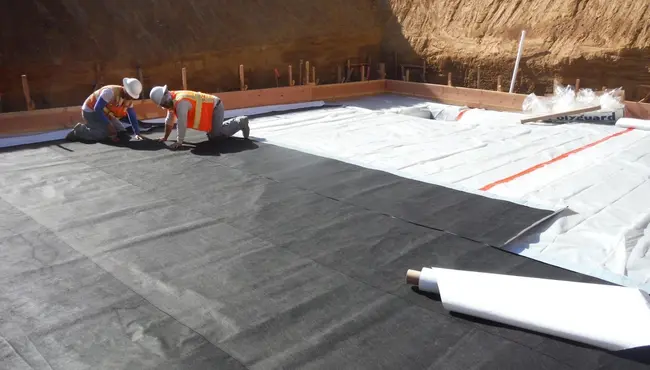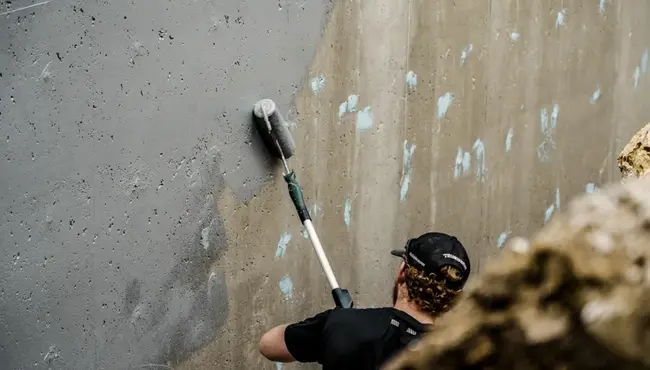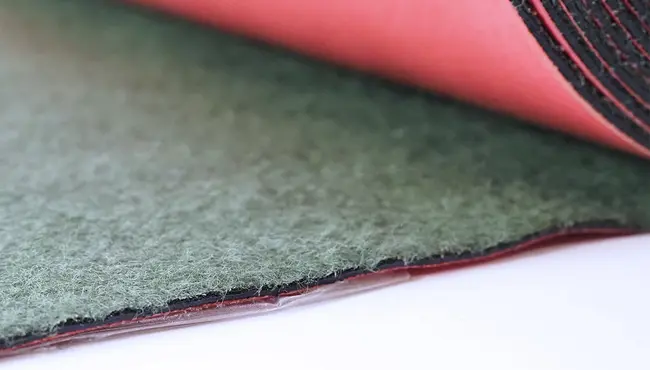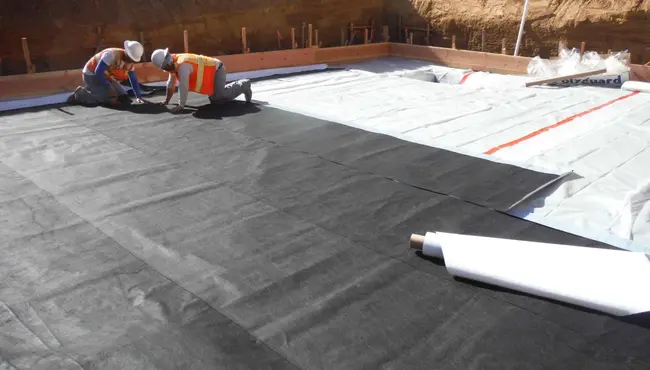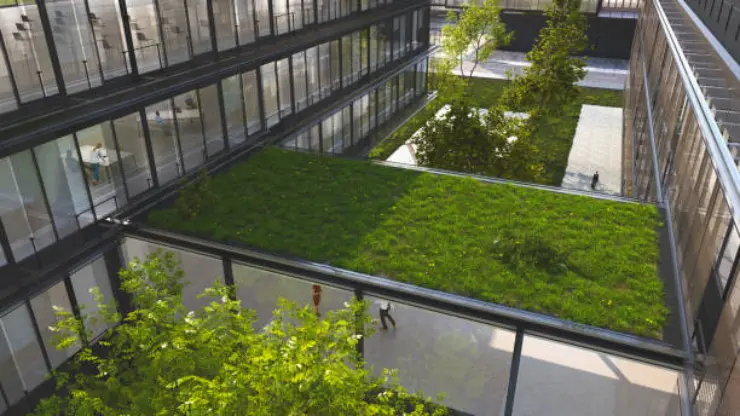
Green roofs offer a range of benefits from stormwater management to improving a building's energy efficiency. However, the success of any green roof relies heavily on proper drainage systems to manage water flow, prevent structural damage, and maintain plant health.
Polyguard provides industry-leading drainage solutions that ensure green roofs perform optimally, contributing to the longevity of the roof while promoting environmental sustainability.
The Basics of Green Roof Systems
A green roof, also known as a vegetated or eco-roof, is a layered system installed on the roof of a building that allows vegetation to grow. Green roofs are designed to support plant life while providing ecological and architectural benefits, making them popular in urban settings. They are categorized into two main types: extensive and intensive.
- Extensive green roofs are lightweight, featuring shallow soil (2-6 inches deep) and low-maintenance, drought-resistant plants like sedum. These systems are ideal for projects where minimal structural changes are required.
- Intensive green roofs have deeper soil layers (6-12 inches or more), which can support larger vegetation like shrubs and trees. These roofs require more robust structural support due to their heavier weight and are often used in more complex, high-maintenance designs.
Green roofs are multi-layered, starting with a waterproofing membrane, followed by a drainage layer, filter fabric, growing medium, and vegetation. These components work together to manage stormwater, enhance energy efficiency, and create natural urban spaces.
A well-designed green roof is only as effective as the drainage system that supports it, ensuring the roof remains functional and sustainable over the long term.
The Role of Drainage in Green Roof Longevity
Efficient green roof drainage is fundamental in preventing water accumulation, which could compromise the roof’s integrity and plant health. By facilitating water retention and controlled runoff, drainage systems manage stormwater effectively, reducing urban flooding and alleviating the strain on sewer systems. Additionally, green roofs are known for retaining 70-90% of precipitation in summer and 25-40% during winter. Beyond stormwater management, proper drainage contributes to energy efficiency by helping regulate roof temperatures throughout the year.
Polyguard’s drainage products provide tailored solutions that protect roofs from water damage while optimizing water management for green roof vegetation.
Additional Benefits of Green Roofs
Beyond their core function in stormwater management and energy efficiency, green roofs provide other key advantages:
- Noise Reduction: Green roofs act as sound insulators, reducing noise transmission by 20-40 decibels, which is especially beneficial for buildings in busy urban environments.
- Urban Cooling: By absorbing sunlight and reducing surface temperatures, green roofs help mitigate the Urban Heat Island (UHI) effect, contributing to cooler cities and reducing the demand for air conditioning.
- Biodiversity: Green roofs support biodiversity by creating habitats for plants, insects, and birds, enhancing ecological conservation efforts in urban areas.
These additional benefits make green roofs a valuable solution for improving urban spaces while contributing to environmental sustainability. To ensure long-term performance and protection, every green roof requires a carefully designed drainage system made up of key components that manage water flow and prevent damage to the structure.
Essential Drainage Components for a Long-Lasting Green Roof
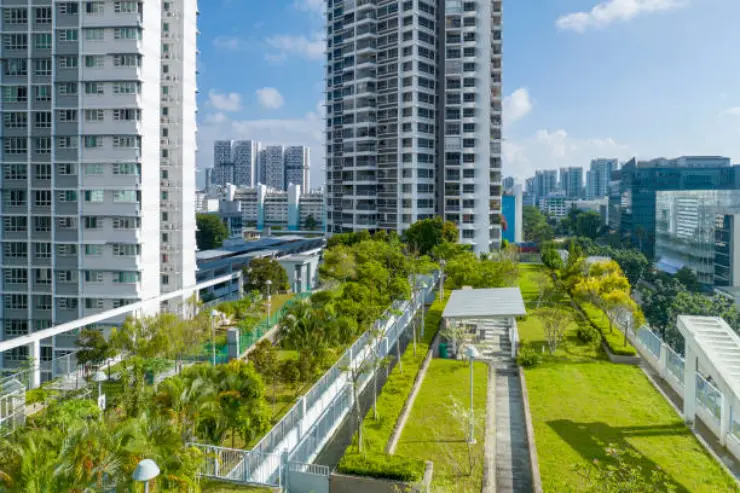
A well-designed drainage system includes several components, each critical for managing water and ensuring overall roof performance.
Waterproofing Membrane
The first layer in a green roof assembly is the waterproofing membrane. This barrier prevents water from entering the building structure and blocks soil from penetrating the roof. This layer must be carefully sealed to prevent water leakage. Polyguard offers high-performance waterproofing systems that are designed to protect structures from moisture intrusion, similar to their balcony waterproofing solutions.
Drainage Layer
The drainage layer moves excess water away from the growing medium. Depending on the roof type, the thickness varies between 10 mm for shallow extensive systems to 50 mm for intensive roofs. Polyguard’s drainage systems, including their pre-assembled drain cores, are engineered to maintain efficient water flow, supporting even heavier vegetation loads.
Filter Fabric
Installed between the drainage layer and the growing medium, the filter fabric prevents soil from clogging the drainage system. It allows water to pass while keeping fine particles out of the drainage layer, ensuring consistent water flow. Polyguard’s Polyflow® 18 drainage system includes a non-woven filter fabric, which is specifically designed to work in tandem with the drainage core to maintain efficient water flow and prevent soil migration.
Key technical features of the filter fabric in the Polyflow® 18 system include:
- Non-Woven Geotextile: This fabric is engineered to provide superior durability and filtration. It acts as a barrier to prevent soil and fine particles from entering and clogging the drainage layer, ensuring the longevity of the drainage system.
- Water Permeability: The filter fabric allows for high water flow through the drainage system while maintaining optimal soil retention. This permeability ensures that excess water can pass through without causing soil erosion or compromising the vegetation above.
- Tensile Strength: The geotextile material used in Polyflow® 18 offers strong tensile strength, ensuring that the fabric remains intact during installation and under the weight of vegetation and soil.
- Chemical and UV Resistance: This filter fabric is resistant to UV rays and various chemicals, making it durable in harsh environmental conditions and ensuring long-term performance.
Growing Medium and Vegetation
The growing medium is carefully selected to balance moisture retention and drainage. Lightweight, well-draining soil ensures that plants receive adequate water without waterlogging the system. Polyguard’s systems support various growing mediums that foster healthy plant growth across different roof types.
Designing an efficient green roof drainage system requires careful consideration of various factors that impact water management, structural integrity, and overall roof longevity.
How to Design an Efficient Green Roof Drainage System
Designing a green roof drainage system requires attention to various factors that influence water management and roof longevity.
Roof Slope and Structure
The roof’s slope impacts how water flows across the surface. Steeper roofs naturally shed water faster, requiring simpler drainage systems. Flatter roofs, however, need more robust drainage layers to prevent water from pooling.
Load Capacity
Green roofs add significant weight to a building, especially when water is retained in the growing medium. Engineers must assess the building’s structural load capacity to ensure the roof can support the combined weight of vegetation, water, and drainage layers. Extensive systems, being lighter, typically require fewer structural adjustments.
Climate and Rainfall Patterns
Local weather conditions play a significant role in drainage design. The system must handle heavy rainfall while ensuring enough water is retained during dry periods for plant health.
Sustainable Materials
Sustainability is increasingly important in green roof design. Choosing drainage materials that are eco-friendly or made from recycled content aligns with the environmental goals of most green roof projects. Polyguard’s drainage products, built with sustainability in mind, contribute to reducing the overall environmental impact of green roofs.
Once the design is in place, proper installation and regular maintenance are critical to ensuring the drainage system continues to protect the green roof and perform efficiently over time.
Installing and Maintaining a Green Roof Drainage System
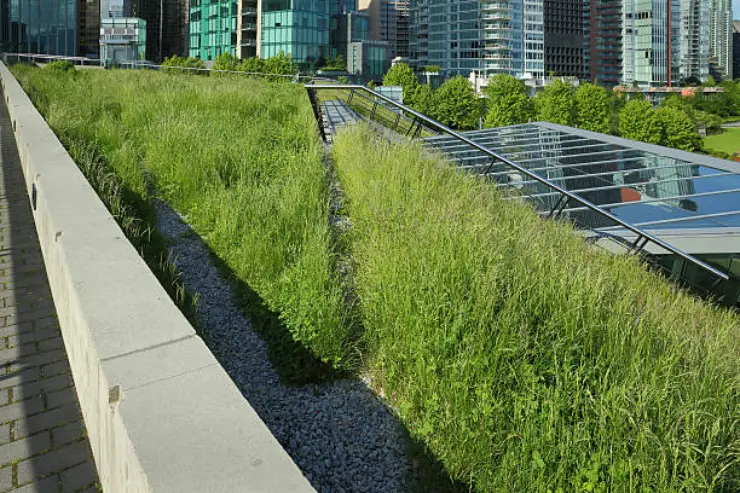
Proper installation and maintenance of green roof drainage systems are essential for long-term performance. In addition to standard upkeep, preparing the drainage system for seasonal changes, particularly in winter, is crucial to ensuring the roof remains functional year-round.
- Prepare the Roof Surface: Clear debris and inspect the roof for damage before laying down the waterproofing layer. This inspection is especially important before winter, as snow and ice accumulation can exacerbate any existing vulnerabilities.
- Install the Waterproofing Membrane: This layer must be carefully sealed to prevent water leakage, particularly in colder climates where freezing and thawing cycles can put extra stress on the membrane. Polyguard’s Balconyguard™ membrane is an ideal solution for cold-weather protection, providing robust performance against moisture and frost.
- Lay the Drainage Layer: Ensure the drainage layer covers the entire roof to manage water flow effectively. In regions with heavy snowfall, choose a drainage system that can handle melting snow to prevent pooling and refreezing, which could damage the roof structure.
- Winterizing the Drainage System: Before winter arrives, inspect the drainage system to ensure no blockages are present. Clogged drains can lead to ice dams, which can damage both the roof and the drainage components. It’s also essential to check for proper drainage flow after the first snowmelt to ensure the system is working as intended.
- Apply the Filter Fabric: The filter fabric protects the drainage layer from debris, ensuring efficient water movement. Regularly inspect the filter fabric before the first frost, as debris buildup can hinder proper drainage when snow starts to melt.
- Install the Growing Medium and Vegetation: Carefully apply the soil and plant appropriate vegetation for the system type. During winter, plants may go dormant, so it’s important to monitor root health and ensure the growing medium is adequately aerated to handle freeze-thaw cycles.
- Routine Inspections: In addition to regular checks for clogs, snow removal may be necessary to prevent excess weight on the green roof. Ensure that snow is removed carefully without damaging the vegetation or drainage components. After winter, a thorough inspection of all drainage elements should be performed to identify any damage caused by freezing temperatures.
By taking these additional seasonal precautions, your green roof drainage system will be better equipped to handle the stresses of winter, preventing damage and ensuring long-term functionality.
Choose Polyguard for Your Green Roof Solutions
A well-functioning green roof needs more than just plants—it requires a dependable drainage system that ensures long-term performance and sustainability. Polyguard offers a wide range of advanced waterproofing and drainage solutions, designed to meet the unique demands of both extensive and intensive green roofs. With decades of experience, we provide durable, efficient products that support healthy plant growth and protect your roof structure.
Contact us today for more information.
